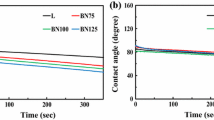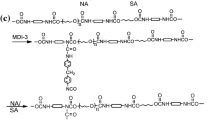Abstract
The antifungal agent carbendazim and the water-compatible functional group 2,4,6-tris(dimethylaminomethyl)phenol (TDMP) were jointly grafted to polyurethane (PU) to develop a water-compatible antifungal PU. The water compatibility of the PU surface improved strikingly after the protonation of TDMP, as confirmed by water contact angle tests. The combined grafting of carbendazim and TDMP affected the melting and glass transition of soft segments and sharply increased the tensile stress and shape recovery capability. Carbendazim was selected as a grafted antifungal functional group due to its wide effective range of antifungal activity and its large production volume. PUs with grafted carbendazim and TDMP completely suppressed the growth of a mixture of fungi, unlike ordinary PU. Therefore, the joint grafting of both carbendazim and TDMP led to improved water compatibility, breaking tensile stress, shape recovery capability, and antifungal activity.








Similar content being viewed by others
References
Munoz-Bonilla A, Fernández-García M (2012) Polymeric materials with antimicrobial activity. Prog Polym Sci 37:281–339
El-Refaie K, Worley SD, Broughton R (2007) The chemistry and applications of antimicrobial polymers: a state-of-the-art review. Biomacromolecules 8:1359–1384
Liu R, Chen X, Hayouka Z, Chakraborty S, Falk SP, Weisblum B, Masters KS, Gellman SH (2013) Nylon-3 polymers with selective antifungal activity. J Am Chem Soc 135:5270–5273
Rogalskyy S, Bardeau JF, Tarasyuk O, Fatyeyeva K (2012) Fabrication of new antifungal polyamide-12 material. Polym Int 61:686–691
Meng N, Zhou NL, Zhang SQ, Shen J (2009) Synthesis and antifungal activities of polymer/montmorillonite–terbinafine hydrochloride nanocomposite films. Appl Clay Sci 46:136–140
Paladini F, Cooper IR, Pollini M (2014) Development of antibacterial and antifungal silver-coated polyurethane foams as air filtration units for the prevention of respiratory diseases. J Appl Microbiol 116:710–717
Xia N, Li N, Rao W, Yu J, Wu Q, Tan L, Li H, Gou L, Liang P, Li L, Meng X (2019) Multifunctional and flexible ZrO2-coated EGaIn nanoparticles for photothermal therapy. Nanoscale 11:10183–10189
Gulla S, Lomada D, Srikanth V, Shankar MV, Reddy KR, Soni S, Reddy MC (2019) Recent advances in nanoparticles-based strategies for cancer therapeutics and antibacterial applications. Methods Microbiol 46:255–293
Reddy KR, Reddy PA, Reddy CV, Shetti NP, Babu B, Ravindranadh K, Shankar MV, Reddy MC, Soni S, Naveen S (2019) Functionalized magnetic nanoparticles/biopolymer hybrids: synthesis methods, properties and biomedical applications. Methods Microbiol 46:227–254
Sharma P, Pant S, Dave V, Tak K, Sadhu V, Reddy KR (2019) Green synthesis and characterization of copper nanoparticles by Tinospora cardifolia to produce nature-friendly copper nano-coated fabric and their antimicrobial evaluation. J Microbiol Meth 160:107–116
Misra A, Jain S, Kishore D, Dave V, Reddy KR, Sadhu V, Dwivedi J, Sharma S (2019) A facile one pot synthesis of novel pyrimidine derivatives of 1,5-benzodiazepines via domino reaction and their antibacterial evaluation. J Microbiol Methods 163:105648
Nagaraja A, Jalageri MD, Puttaiahgowda YM, Reddy KR, Raghu AV (2019) A review on various maleic anhydride antimicrobial polymers. J Microbiol Methods 163:105650
Subhani Q, Huang ZH, Zhu Z, Zhu Y (2013) Simultaneous determination of imidacloprid and carbendazim in water samples by ion chromatography with fluorescence detector and post-column photochemical reactor. Talanta 16:127–132
Patel GM, Rohit JV, Singhal RK, Kailasa SK (2015) Recognition of carbendazim fungicide in environmental samples by using 4-aminobenzenethiol functionalized silver nanoparticles as a colorimetric sensor. Sens Actuators B Chem 206:684–691
Sheehan DJ, Hitchcock CA, Sibley CM (1999) Current and emerging azole antifungal agents. Clin Microbiol Rev 12:40–79
Yang Y, Wang H, Huang L, Zhang S, He Y, Gao Q, Ye Q (2017) Effects of superabsorbent polymers on the fate of fungicidal carbendazim in soils. J Hazard Mater 328:70–79
Xu JC, Rong XS, Tian T, Qiu FX (2014) Study on the determination of carbendazim in water and vegetable samples. Adv Mater Res 55:1351–1354
Pourreza N, Rastegarzadeh S, Larki A (2015) Determination of fungicide carbendazim in water and soil samples using dispersive liquid-liquid microextraction and microvolume UV–vis spectrophotometry. Talanta 134:24–29
Rodriguez-Cuesta MJ, Boque R, Rius FX, Picon Zamora D, Martinez Galera M, Garrido Frenich A (2003) Determination of carbendazim, fuberidazole and thiabendazole by three-dimensional excitation–emission matrix fluorescence and parallel factor analysis. Anal Chim Acta 491:47–56
Cachoa C, Turiel E, Pérez-Conde C (2009) Molecularly imprinted polymers: an analytical tool for the determination of benzimidazole compounds in water samples. Talanta 78:1029–1035
Li WR, Xie XB, Shi QS, Zeng HY, Ou-Yang YS, Chen YB (2010) Antibacterial activity and mechanism of silver nanoparticles on Escherichia coli. Appl Microbiol Biotechnol 85:1115–1122
Cerrada ML, Serrano C, Sánchez-Chaves M, Fernández-García M, Fernández-Martín F, de Andres A, Rioboo RJJ, Kubacka A, Ferrer M, Fernández-García M (2008) Self-sterilized EVOH-TiO2 nanocomposites: interface effects on biocidal properties. Adv Funct Mater 18:1949–1960
Popa A, Davidescu CM, Trif R, Ilia G, Iliescu S, Dehelean G (2003) Study of quaternary phosphonium salts grafted on polymers: antibacterial activity of quaternary phosphonium salts grafted on geltype’ styrene-divinylbenzene copolymers. React Funct Polym 55:151–158
Tamaki M, Kokuno M, Sasaki I, Suzuki Y, Iwama M, Saegusa K, Kikuchi Y, Shindo M, Kimura M, Uchida Y (2009) Syntheses of lowhemolytic antimicrobial gratisin peptides. Bioorg Med Chem Lett 19:2856–2859
Feiertag P, Albert M, Ecker-Eckhofen E-M, Hayn G, Hönig H, Oberwalder HW, Saf R, Schmidt A, Schmidt O, Topchiev D (2003) Structural characterization of biocidal oligoguanidines. Macromol Rapid Commun 24:567–570
Seymour RB, Kauffman GB (1992) Polyurethanes: a class of modern versatile materials. J Chem Ed 69:909–910
Engels HW, Pirkl HG, Albers R, Albach RW, Krause J, Hoffmann A, Casselmann H, Dormish J (2013) Polyurethanes: versatile materials and sustainable problem solvers for today's challenges. Angew Chem Int Ed 52:9422–9441
Zdrahala RJ, Zdrahala IJ (1999) Biomedical applications of polyurethanes: a review of past promises, present realities, and a vibrant future. J Biomater Appl 14:67–90
Nevejans S, Ballarda N, Fernández M, Reck B, Asua JM (2019) Flexible aromatic disulfide monomers for high-performance self-healable linear and cross-linked poly(urethane-urea) coatings. Polymer 166:229–238
Choi SH, Kim DH, Raghu AV, Reddy KR, Lee HI, Yoon KS, Jeong HM, Kim BK (2012) Properties of graphene/waterborne polyurethane nanocomposites cast from colloidal dispersion mixtures. J Macromol Sci B 51:197–207
Reddy KR, Raghu AV, Jeong HM, Siddaramaiah S (2012) Synthesis and characterization of pyridine-based polyurethanes. Des Monomers Polym 12:109–118
Reddy KR, Raghu AV, Jeong HM (2008) Synthesis and characterization of novel polyurethanes based on 4,4′-{1,4-phenylenebis[methylylidenenitrilo]} diphenol. Polym Bull 60:609–616
Sellenet PH, Allison B, Applegate BM, Youngblood JP (2007) Synergistic activity of hydrophilic modification in antibiotic polymers. Biomacromolecules 8:19–23
Chung YC, Kim HY, Choi JW, Chun BC (2015) Preparation of water-compatible antifungal polyurethane with grafted benzimidazole as the antifungal agent. J Appl Polym Sci 132:41676–41684
Chung YC, Kim HY, Choi JW, Chun BC (2017) Effect of the ionized carboxyl group on the water compatibility and the antifungal activity of the benzimidazole-grafted polyurethane. Polym Bull 74:3721–3737
Kim HY, Choi JW, Chung YC, Chun BC (2017) The grafting of recycled polyol from waste polyurethane foam onto new polyurethane and its impact on shape recovery and water vapor permeation. Fiber Polym 18:842–851
Chung YC, Kim HY, Choi JW, Chun BC (2015) Modification of polyurethane by graft polymerization of poly (acrylic acid) for the control of molecular interaction and water compatibility. Polym Bull 72:2685–2703
Moss RA, Chung YC (1990) An efficient iodosobenzoate-functionalized polymer for the cleavage of reactive phosphates. Langmuir 6:1614–1616
Tischer M, Pradel G, Ohlsen K, Holzgrabe U (2012) Quaternary ammonium salts and their antimicrobial potential: targets or nonspecific interactions. ChemMedChem 7:22–31
Tan K, Obendorf SK (2006) Surface modification of microporous polyurethane membrane with poly(ethylene glycol) to develop a novel membrane. J Membr Sci 274:150–157
Tan K, Obendorf SK (2007) Development of an antimicrobial microporous polyurethane membrane. J Membr Sci 289:199–209
Chung YC, Kim DE, Choi JW, Chun BC (2019) The temperature-sensitive water vapor permeation control of polyurethane membrane using the graft-polymerized poly(N-isopropylacrylamide) and the impact on the tensile strength and shape recovery effect. Polym Plast Technol 58:656–666
Chung YC, Kim SH, Bae JC, Chun BC (2018) Grafting of triphenylmethyl group onto polyurethane and the impact on the shape recovery and flexibility at extremely low temperature. Fiber Polym 19:1157–1165
Sekkar V, Gopalakrishnan S, Ambika Devi K (2003) Studies on allophanate-urethane networks based on hydroxyl terminated polybutadiene: effect of isocyanate type on the network characteristics. Eur Polym J 39:1281–1290
Sekkar V, Rama Rao M, Krishinamurthy VN, Jane SR (1996) Modeling of polyurethane networks based on hydroxy-terminated polybutadiene and poly(12-hydroxy stearic acid–co–TMP) ester polyol: correlation of network parameters with mechanical properties. J Appl Polym Sci 62:2317–2327
Cho JW, Jung YC, Chun BC, Chung YC (2004) Water vapor permeability and mechanical properties of fabrics coated with shape-memory polyurethane. J Appl Polym Sci 92:2812–2816
Freij-Larsson C, Wesslen B (1993) Grafting of polyurethane surfaces with poly(ethylene glycol). J Appl Polym Sci 50:345–352
Archambault JG, John L (2004) Protein resistant polyurethane surfaces by chemical grafting of PEO: amino-terminated PEO as grafting reagent. Colloids Surf B 39:9–16
Chung YC, Lee DH, Choi JW, Chun BC (2018) Application of recycled polyol and benzimidazole to the enhancement of antifungal activity of polyurethane. J Appl Polym Sci 135:46600–46610
Chung YC, Kim HY, Choi JW, Chun BC (2018) Graft polymerization of 4-imidazole acrylic acid onto polyurethane for the improvement of water compatibility and antifungal activity. Polym Eng Sci 58:2088–2097
Chung YC, Choi JW, Chung HM, Chun BC (2012) The MDI-mediated lateral crosslinking of polyurethane copolymer and the impact on tensile properties and shape memory effect. Bull Korean Chem Soc 33:692–694
Choi T, Weksler J, Padsalgikar A, Runt J (2010) Microstructural organization of polydimethylsiloxane soft segment polyurethanes derived from a single macrodiol. Polymer 51:4375–4382
Russo P, Lavorgna M, Piscitelli F, Acierno D, Di Maio L (2013) Thermoplastic polyurethane films reinforced with carbon nanotubes: the effect of processing on the structure and mechanical properties. Eur Polym J 49:379–388
Kenawy ER, Al-Deyab SS, Omar Shaker N, El-Sadek BM, Khattab AHB (2009) Synthesis and antimicrobial activity of metronidazole containing polymer and copolymers. J Appl Polym Sci 113:818–826
Aumsuwan N, Danyus RC, Heinhorst S, Urban MW (2008) Attachment of ampicillin to expanded poly(tetrafluoroethylene): surface reactions leading to inhibition of microbial growth. Biomacromolecules 9:1712–1718
Kugel A, Chisholm B, Ebert S, Jepperson M, Jarabek L, Stafslien S (2010) Antimicrobial polysiloxane polymers and coatings containing pendant levofloxacin. Polym Chem 1:442–452
Aumsuwan N, Heinhorst S, Urban MW (2007) The effectiveness of antibiotic activity of penicillin attached to expanded poly(tetrafluoroethylene) (ePTFE) surfaces: a quantitative assessment. Biomacromol 8:3525–3530
Badrossamay MR, Sun G (2009) A study on melt grafting of N-halamine moieties onto polyethylene and their antibacterial activities. Macromolecules 42:1948–1954
Piccirillo C, Perni S, Gil-Thomas J, Prokopovich P, Wilson M, Pratten J, Parkin IP (2009) Antimicrobial activity of methylene blue and toluidine blue O covalently bound to a modified silicone polymer surface. J Mater Chem 19:6167–6171
Funding
This research was supported by Basic Science Research Program through the National Research Foundation of Korea (NRF) funded by the Ministry of Education (NRF-2016R1D1A1B01014308).
Author information
Authors and Affiliations
Corresponding author
Additional information
Publisher's Note
Springer Nature remains neutral with regard to jurisdictional claims in published maps and institutional affiliations.
Rights and permissions
About this article
Cite this article
Chung, YC., Park, J.E., Choi, J.W. et al. The grafted carbendazim and 2,4,6-tris(dimethylaminomethyl)phenyl group onto polyurethane to improve its antifungal effectiveness and hydrophilicity. Polym. Bull. 78, 621–642 (2021). https://doi.org/10.1007/s00289-020-03126-2
Received:
Revised:
Accepted:
Published:
Issue Date:
DOI: https://doi.org/10.1007/s00289-020-03126-2




